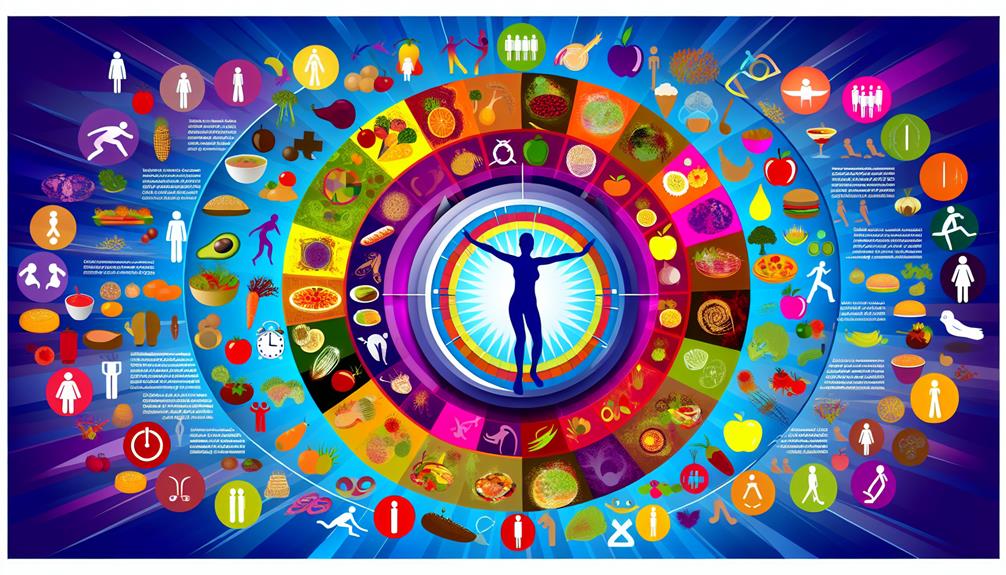Think of your body as a finely tuned engine; if you put in the wrong fuel, it won't run efficiently. When it comes to intermittent fasting, figuring out how many calories you need isn't a one-size-fits-all answer. Factors like your age, gender, and activity level play significant roles in determining your caloric intake. So, how do you take the first step toward finding your ideal caloric balance? Understanding your unique needs could be the key to maximizing the benefits of your fasting journey.
Understanding Intermittent Fasting
Intermittent fasting (IF) has gained popularity as a flexible approach to eating that can support weight loss and improve metabolic health. Many people find that it helps them manage their food intake without the need for strict dieting. One of the primary benefits of fasting is its potential to enhance fat loss by promoting the use of stored fat for energy during fasting periods. Additionally, IF can improve insulin sensitivity, which is vital for regulating blood sugar levels.
However, there are some fasting myths that can lead to confusion. For instance, some believe that fasting means you can't eat anything at all. In reality, many IF protocols allow for non-caloric beverages like water, tea, or coffee during fasting windows. Another common myth is that fasting will slow down your metabolism markedly; studies show that short-term fasting can actually boost metabolic rate due to increased norepinephrine production.
As you explore intermittent fasting, it's important to understand that it's not a one-size-fits-all solution. What works for one person may not work for another, and it's vital to listen to your body. Always consult with a healthcare professional before making considerable changes to your eating patterns, especially if you have underlying health conditions. By debunking these myths and understanding the true benefits of fasting, you can make informed decisions about whether IF is right for you.
Caloric Needs Overview
Understanding your daily caloric requirements is essential when practicing intermittent fasting. Several factors, such as your age, gender, activity level, and overall health, influence how much you should consume. By recognizing these elements, you can tailor your approach to meet your unique caloric needs effectively.
Daily Caloric Requirements
When considering your daily caloric requirements, it is essential to recognize that these needs can vary widely based on factors like age, gender, weight, height, and activity level. Your basal metabolic rate (BMR) plays an important role in determining how many calories you need each day. This is the number of calories your body requires to maintain basic physiological functions, such as breathing and circulation, while at rest.
To maintain your weight, you need to consume calories that match your total daily energy expenditure (TDEE), which includes your BMR plus calories burned through physical activity. If you aim to lose weight, creating a caloric deficit—consuming fewer calories than your TDEE—is fundamental. This approach forces your body to utilize stored fat for energy, leading to weight loss over time.
Conversely, if your goal is to gain weight, you should consume more calories than your TDEE. Understanding your specific daily caloric requirements is essential for effective intermittent fasting, as it helps you plan your eating windows and manage your energy balance effectively. Tailoring your caloric intake based on these factors will support your health and fitness goals.
Factors Influencing Intake
Determining your caloric needs involves considering several factors that can influence your intake. One key aspect is hormonal changes, which can greatly affect your appetite and metabolism. For example, during intermittent fasting, fluctuations in hormones like ghrelin and leptin can alter your hunger levels and energy expenditure.
Metabolic adaptation also plays a role; your body may adjust its energy requirements based on your diet and fasting schedule. This means there's individual variability in how different people respond to the same caloric intake.
Lifestyle factors, such as your daily activity level and stress, can further influence how many calories you need. Meal timing is essential too; consuming your meals within a specific window may affect your hunger and fullness cues.
Additionally, food quality matters. Focusing on nutrient-dense foods can help with hunger management, ensuring you feel satisfied without exceeding caloric limits. Prioritizing whole foods over processed options can make a considerable difference in your overall intake. By understanding these factors, you can tailor your intermittent fasting approach to suit your unique needs and goals.
Factors Affecting Caloric Intake

Caloric intake during intermittent fasting often varies based on several key factors that influence individual dietary needs. One significant factor is your metabolism effects, which can differ greatly among individuals. A faster metabolism may allow you to consume more calories without gaining weight, while a slower one might require stricter caloric control.
Hunger management is another vital aspect. During your eating windows, how well you manage hunger can dictate your caloric intake. Choosing nutrient-dense foods can help you feel full longer, making it easier to stick to your plan. Additionally, nutrient timing plays a role; consuming the right nutrients at strategic times can optimize your energy levels and overall satisfaction.
Meal frequency can also impact your caloric intake. Some may find that eating fewer meals during their eating window helps them control their overall calories, while others might feel better with more frequent, smaller meals. Your food choices directly affect your energy balance; opting for high-quality foods over processed ones usually leads to better outcomes.
Lifestyle factors, including physical activity levels and stress, can influence your caloric needs and hunger cues. Finally, don't underestimate the importance of hydration. Staying well-hydrated can help manage hunger and improve overall well-being, allowing you to make better food choices. By considering these factors, you can tailor your caloric intake to suit your specific needs during intermittent fasting.
Common Intermittent Fasting Methods
Intermittent fasting encompasses several popular methods that can fit various lifestyles and goals. One of the most common approaches is the 16/8 method, where you fast for 16 hours and eat during an 8-hour window. This method allows for flexibility in scheduling meals and is often easier to integrate into daily life.
Another method is alternate day fasting, which involves alternating between days of regular eating and days where you either fast completely or limit calorie intake to about 500-600 calories. This can be effective for those looking for a more intense fasting approach.
The warrior diet combines a 20-hour fasting period with a 4-hour eating window, emphasizing the consumption of raw fruits and vegetables during the day, followed by a large meal at night. This method can suit individuals who prefer a more structured eating schedule.
Eat Stop Eat is another popular method, where you fast for a full 24 hours once or twice a week. This can be challenging but may lead to significant results for those who can manage the extended fasting period.
Spontaneous fasting allows you to skip meals occasionally when it feels right, making it a more flexible option for those just starting out. Finally, time-restricted eating focuses on limiting the hours you eat each day, similar to the 16/8 method but with various fasting windows.
Ultimately, selecting a method that aligns with your lifestyle and preferences is key to successful intermittent fasting.
Calculating Your Daily Calories

Understanding how many calories you should consume daily is essential for effectively implementing intermittent fasting. To determine your daily caloric needs, start by calculating your Basal Metabolic Rate (BMR), which estimates the calories your body requires at rest. You can use various online calculators or the Mifflin-St Jeor equation for a more personalized estimate.
Once you have your BMR, factor in your activity level to find your Total Daily Energy Expenditure (TDEE). This number reflects the calories you need to maintain your current weight. If your goal is weight loss, aim for a caloric deficit by consuming fewer calories than your TDEE.
Incorporate the concept of caloric density into your meal planning. Foods with low caloric density, like fruits and vegetables, allow you to eat larger portions while keeping your calorie intake in check. Conversely, high-caloric density foods, such as nuts and oils, should be consumed in moderation to avoid exceeding your daily limits.
Meal timing is another critical aspect of intermittent fasting. When you have a designated eating window, you'll need to plan your meals to guarantee you're getting enough nutrients and calories. Focus on nutrient-dense foods during this period to maximize the benefits of your eating schedule.
Sample Meal Plans
When it comes to meal planning during intermittent fasting, having a structured approach can make a significant difference in achieving your health goals. By creating sample meal plans, you can guarantee you're getting the right nutrients within your eating window while adhering to your calorie goals.
For a 16:8 fasting protocol, you might break your fast at noon. Your first meal could include a spinach and feta omelet, paired with whole-grain toast. This meal is high in protein and healthy fats, setting a solid foundation for your day. For lunch, consider a quinoa salad with chickpeas, cherry tomatoes, cucumber, and a lemon-tahini dressing. This meal timing allows you to stay energized and satiated.
As your eating window continues, around 6 PM, you could enjoy grilled salmon with roasted vegetables. This dish provides omega-3 fatty acids and fiber, essential for overall health. For a light snack, a handful of almonds or a small bowl of Greek yogurt with berries can help satisfy cravings without excessive calories.
Incorporating sample recipes like these into your meal plans can help you maintain variety and enjoyment in your diet. Remember, the key is balancing macronutrients while staying within your caloric limits. Tracking your meals and adjusting portion sizes can aid in fine-tuning your plan to meet your specific needs. This structured approach not only enhances your fasting experience but also contributes to long-term success.
Tips for Success

Successful intermittent fasting hinges on a few key strategies that can enhance your experience and results. First, pay close attention to meal timing. Establish a consistent schedule that works for you, whether it's an 8-hour eating window or another method. Sticking to a routine helps regulate your body's internal clock and can make it easier to adhere to your fasting periods.
Next, learn to recognize your hunger cues. It's normal to feel hungry when you begin intermittent fasting, but it's vital to differentiate between true hunger and mere cravings. When you eat, focus on nutrient-dense foods that keep you satiated longer, such as lean proteins, healthy fats, and lots of fruits and vegetables. This balanced approach can help minimize the discomfort of hunger during fasting periods.
Staying hydrated is also essential. Water, herbal teas, and black coffee can help curb hunger and keep you feeling full. Sometimes, what feels like hunger is actually dehydration.
Additionally, consider incorporating mindful eating practices during your eating windows. This means slowing down and savoring your meals, which can improve digestion and satisfaction.
Lastly, be patient with yourself. It may take time to adjust, and occasional slip-ups are part of the process. Focus on your long-term goals and remember that consistency is key. By implementing these tips, you'll be better prepared to succeed with your intermittent fasting journey.
Frequently Asked Questions
Can I Drink Coffee During My Fasting Hours?
Yes, you can drink coffee during fasting hours. Coffee benefits include improved focus and appetite suppression, which can help enhance fasting effects. Just be mindful of added sugars or cream, as they can break your fast.
Will I Lose Muscle Mass With Intermittent Fasting?
You might worry about muscle loss during intermittent fasting, but studies show that muscle preservation is possible. By combining proper nutrition and resistance training, you can enjoy fasting benefits without sacrificing muscle mass.
Is Intermittent Fasting Suitable for Everyone?
Intermittent fasting can offer health benefits, but it isn't suitable for everyone. Individual differences, such as medical conditions and lifestyle, play an essential role in determining if this approach aligns with your specific needs and goals.
How Does Intermittent Fasting Affect Metabolism?
Intermittent fasting can boost your metabolic rate and enhance insulin sensitivity. This means your body may burn calories more efficiently, which can support weight management and overall health when practiced thoughtfully and combined with a balanced diet.
Can I Adjust My Fasting Schedule Weekly?
Imagine a painter with a flexible canvas; you can absolutely adjust your fasting schedule weekly. Embracing fasting flexibility allows for schedule variations, helping you find what best suits your lifestyle while still reaping health benefits.
Conclusion
In summary, determining your caloric needs during intermittent fasting is essential for achieving your health goals. For instance, if Sarah, a 30-year-old active woman, calculates her TDEE at 1,800 calories, she might aim for a daily intake of 1,500 calories to create a deficit. By focusing on nutrient-dense foods and listening to her body's hunger cues, she can effectively manage her weight while enjoying the benefits of fasting. Regularly reassessing her plan will keep her on track for sustainable results.